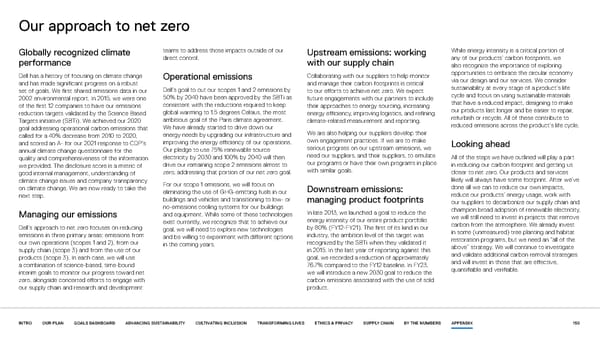Our approach to net zero Globally recognized climate teams to address those impacts outside of our Upstream emissions: working While energy intensity is a critical portion of performance direct control. with our supply chain any of our products’ carbon footprints, we also recognize the importance of exploring Dell has a history of focusing on climate change Operational emissions Collaborating with our suppliers to help monitor opportunities to embrace the circular economy and has made significant progress on a robust and manage their carbon footprints is critical via our design and our services. We consider set of goals. We first shared emissions data in our Dell’s goal to cut our scopes 1 and 2 emissions by to our efforts to achieve net zero. We expect sustainability at every stage of a product’s life 2002 environmental report. In 2015, we were one 50% by 2040 have been approved by the SBTi as future engagements with our partners to include cycle and focus on using sustainable materials of the first 12 companies to have our emissions consistent with the reductions required to keep their approaches to energy sourcing, increasing that have a reduced impact, designing to make reduction targets validated by the Science Based global warming to 1.5 degrees Celsius, the most energy efficiency, improving logistics, and refining our products last longer and be easier to repair, Targets initiative (SBTi). We achieved our 2020 ambitious goal of the Paris climate agreement. climate-related measurement and reporting. refurbish or recycle. All of these contribute to goal addressing operational carbon emissions that We have already started to drive down our reduced emissions across the product’s life cycle. called for a 40% decrease from 2010 to 2020, energy needs by upgrading our infrastructure and We are also helping our suppliers develop their and scored an A- for our 2021 response to CDP’s improving the energy efficiency of our operations. own engagement practices. If we are to make Looking ahead annual climate change questionnaire for the Our pledge to use 75% renewable source serious progress on our upstream emissions, we quality and comprehensiveness of the information electricity by 2030 and 100% by 2040 will then need our suppliers, and their suppliers, to emulate All of the steps we have outlined will play a part we provided. The disclosure score is a metric of drive our remaining scope 2 emissions almost to our programs or have their own programs in place in reducing our carbon footprint and getting us good internal management, understanding of zero, addressing that portion of our net zero goal. with similar goals. closer to net zero. Our products and services climate change issues and company transparency For our scope 1 emissions, we will focus on likely will always have some footprint. After we’ve on climate change. We are now ready to take the eliminating the use of GHG-emitting fuels in our Downstream emissions: done all we can to reduce our own impacts, next step. buildings and vehicles and transitioning to low- or managing product footprints reduce our products’ energy usage, work with no-emissions cooling systems for our buildings our suppliers to decarbonize our supply chain and Managing our emissions and equipment. While some of these technologies In late 2013, we launched a goal to reduce the champion broad adoption of renewable electricity, exist currently, we recognize that to achieve our energy intensity of our entire product portfolio we will still need to invest in projects that remove Dell’s approach to net zero focuses on reducing goal, we will need to explore new technologies by 80% (FY12-FY21). The first of its kind in our carbon from the atmosphere. We already invest emissions in three primary areas: emissions from and be willing to experiment with different options industry, the ambition level of this target was in some (unmeasured) tree planting and habitat our own operations (scopes 1 and 2), from our in the coming years. recognized by the SBTi when they validated it restoration programs, but we need an “all of the supply chain (scope 3) and from the use of our in 2015. In the last year of reporting against this above” strategy. We will continue to investigate products (scope 3). In each case, we will use goal, we recorded a reduction of approximately and validate additional carbon removal strategies a combination of science-based, time-bound 76.7% compared to the FY12 baseline. In FY23, and will invest in those that are effective, interim goals to monitor our progress toward net we will introduce a new 2030 goal to reduce the quantifiable and verifiable. zero, alongside concerted efforts to engage with carbon emissions associated with the use of sold our supply chain and research and development product. INTRO OUR PLAN GOALS DASHBOARD ADVANCING SUSTAINABILITY CULTIVATING INCLUSION TRANSFORMING LIVES ETHICS & PRIVACY SUPPLY CHAIN BY THE NUMBERS APPENDIX 150
 Our purpose in action | Dell Page 149 Page 151
Our purpose in action | Dell Page 149 Page 151